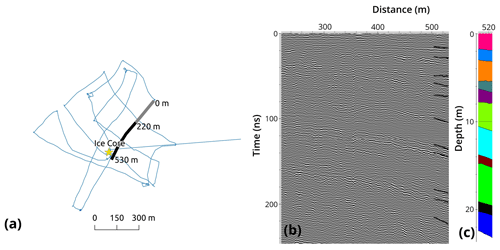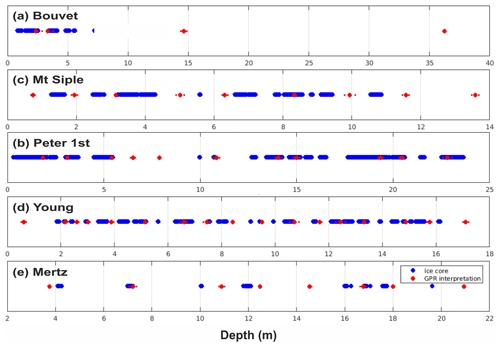the Creative Commons Attribution 4.0 License.
the Creative Commons Attribution 4.0 License.
Physical properties of shallow ice cores from Antarctic and sub-Antarctic islands
Guisella Gacitúa
Joel B. Pedro
Amy Constance Faith King
Bradley Markle
Mariusz Potocki
Dorothea Elisabeth Moser
The sub-Antarctic is one of the most data-sparse regions on earth. A number of glaciated Antarctic and sub-Antarctic islands have the potential to provide unique ice core records of past climate, atmospheric circulation, and sea ice. However, very little is known about the glaciology of these remote islands or their vulnerability to warming atmospheric temperature. Here we present melt histories and density profiles from shallow ice (firn) cores (14 to 24 m) drilled on three sub-Antarctic islands and two Antarctic coastal domes. Additionally, complementary ground-penetrating radar (GPR) data were collected to further characterize each site and assess the spatial distribution of the observed melt layers. This study includes the first ever firn cores from Bouvet Island (54∘25′19′′ S, 03∘23′27′′ E) in the South Atlantic, from Peter I Island (68∘51′05′′ S, 90∘30′35′′ W) in the Bellingshausen Sea, and from Young Island (66∘31′44′′ S, 162∘33′21′′ E) in the Ross Sea sector's Balleny island chain. Despite their sub-Antarctic location, surface melt is low at most sites (melt layers account for ∼ 10 % of total core), with undisturbed ice layers in the upper ∼ 40 m, suggesting minimal impact of meltwater percolation. The exception is Young Island, where melt layers account for 47 % of the firn core. Surface snow densities range from 0.47 to 0.52 kg m−3, with close-off depths ranging from 21 to 51 m. Based on the measured density, we estimate that the bottom ages of a 100 m ice core drilled on Peter 1 Island would reach ∼ 1856 CE and ∼ 1874 CE at Young Island.
- Article
(11392 KB) - Full-text XML
-
Supplement
(301 KB) - BibTeX
- EndNote
The sub-Antarctic region sits at the interface of polar and mid-latitude climate regimes, making it highly sensitive to shifting climate over time. However, the sub-Antarctic and the Southern Ocean region is one of the most data-sparse regions on earth. A recent compilation of climate data spanning the 20th century revealed that of the 692 records that exist globally (Emile-Geay et al., 2017), none are available for the Southern Ocean. The vast expanse of open water makes climate and palaeoclimate observations difficult, but a number of glaciated sub-Antarctic islands (SAIs; defined here as islands south of the Southern Ocean polar front) may be suitable for extracting palaeoclimate information from ice cores (Fig. 1).
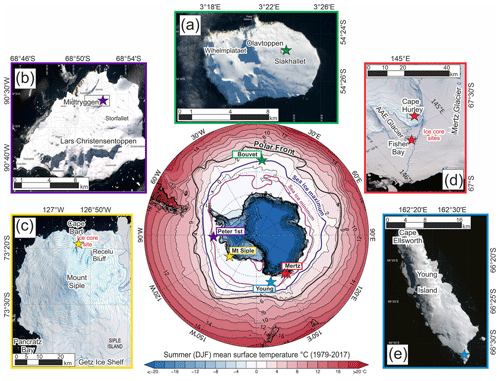
Figure 1Map of subICE ice core locations (stars), with insert maps of each site. Overlain on mean summer surface temperatures (coloured contours) from ERA-5 (1979–2017). Location of the maximum (blue) and minimum (purple) sea ice extent (from the National Snow and Ice Data Centre, NSIDC, 1981–2017) and the polar front (black). (a) Bouvet Island (image credit: Google Earth). (b) Peter I Island and (c) Mount Siple (images from Sentinel-2 Copernicus data). (d) Map of Mertz Glacier, showing the location of the two ice cores from Cape Hurley and Fisher Bay and (e) Young Island (Landsat image courtesy of the US Geological Survey, USGS). All contours derived from the TanDEM-X 90 m digital elevation model (DEM).
Many of these SAIs sit within the westerly wind belt and the transitional sea ice zone (Fig. 1). Westerly winds drive ocean upwelling and basal melt of Antarctic ice shelves (Favier et al., 2014; Joughin et al., 2014), and the 20th-century increase in Antarctic snowfall has been attributed to changes in their circulation (Medley and Thomas, 2019). Sea ice modulates the earth's albedo and governs the area available for exchange of heat and CO2 between the ocean and the atmosphere. However, records of both westerly winds and sea ice are short, with major uncertainty in the trends prior to the satellite era (i.e. pre-1970s). SAIs on the very margin of maximum winter sea ice extent could potentially identify local-scale changes in sea ice rather than rely on ice core records from the Antarctic continent, which record mostly ocean-sector-scale trends (Thomas and Abram, 2016; Thomas et al., 2019). An ice core from Bouvet Island, presented in this study, has already proven successful in reconstructing past sea ice variability in the adjacent ocean (King et al., 2019).
Palaeoclimate records do exist on some SAIs from lake sediments, peat cores, and ice cores. Peat records are currently the most prolific of the three, with a number of records retrieved on the New Zealand SAIs up to 12 000 years old (McGlone, 2002) and on Crozet and South Georgia up to 6000 and 11 000 years old, respectively (Van der Putten et al., 2012). One limitation is that annual layers are not preserved in such records, and carbon dating carries with it uncertainties in the decadal to centennial range, which complicates the identification of annual- to decadal-scale climate variations and the precise timing of climate shifts (Van der Putten et al., 2012). Peat deposits are also lacking on the more southerly SAIs.
Lake sediments are similarly useful for studying vegetation composition on the SAIs. These are related to a wide range of environmental parameters within and around the lake used to reconstruct past natural variability (Saunders et al., 2008). Diatom and geochemical proxies from Marion Island have been used to track the migration of westerly winds over the past 700 years (Perren et al., 2020). A novel proxy, based on sea salt aerosols in lake sediments on Macquarie Island, reconstructed past westerly wind strength over the past 12 300 years (Saunders et al., 2018). However, damage from introduced rabbits at this site has compromised the data during the last ∼ 100 years.
Ice core records offer complementary archives to peat and lake archives on glaciated or ice-capped islands and are in some cases unique records of where peat and lake deposits are not available. Shallow ice cores have been drilled from low-elevation plateaus and glacial termini on South Georgia, the largest glaciated SAI. The estimated age of the ice at bedrock for the glacial termini sites is between 8000–12 000 years old (Mayewski et al., 2016). However, surface temperatures on South Georgia have risen by ∼ 1 ∘C during the 20th century (Whitehead et al., 2008), and 97 % of the 103 coastal glaciers have retreated since the 1950s (Cook et al., 2010). Thus, the valuable palaeoclimate archive contained in South Georgia and potentially the other SAI glaciers may be at risk from surface melt.
The sub-Antarctic Ice Core drilling Expedition (subICE) was part of the international Antarctic Circumnavigation Expedition (ACE) 2017–2018 (Walton, 2018), which offered an exceptional opportunity to access multiple SAIs. In this study we present the density profiles, melt histories, and ground-penetrating radar (GPR) data collected during subICE. These include the first-ever firn core records from three of the glaciated Antarctic islands and SAIs in the Pacific and South Atlantic sector of the Southern Ocean, together with two continental firn cores collected from coastal domes in East and West Antarctica. The aim of this study is to (1) evaluate the firn conditions and internal layering in the upper ice column, (2) determine the extent of surface melt and the potential impact on proxy preservation, and (3) estimate potential bottom ages for future deep-drilling expeditions.
Table 1Site metadata for the subICE cores. Measured GPS location, elevation of ice core, and ice core borehole depth. Annual average P−E, annual average temperature (maximum monthly temperature in brackets) from ERA-5 (1979–2017) at 2 m elevation and corrected for ice core elevation (using a lapse rate of 0.68∘/100 m). Where available the maximum recorded automatic weather station (AWS) temperature is shown at the AWS elevation and corrected for ice core elevations, with years of operation in brackets.
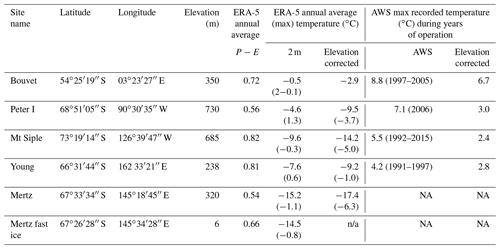
n/a: not applicable. NA: not available.
2.1 Firn cores
Six firn cores were drilled as part of subICE, between January and March 2017 (Table 1). The teams were deployed to the sites via helicopter from the ship Akademik Tryoshnikov, allowing between 3 and 8 hours of drilling time, dependent on weather conditions and logistical capability. The firn cores were drilled using a Mark III Kovacs hand auger with sidewinder winch and power head, retrieving sections of approximately 70 cm in length. The firn was measured, placed inside pre-cut lay-flat tubing, and packed in insulated ice core storage boxes for transportation. During the voyage, the ice was stored in a −25 ∘C freezer and later transported to the ice core laboratories at the British Antarctic Survey (BAS).
2.1.1 Bouvet Island (Bouvetøya)
A 14 m firn core was drilled from the volcanic island of Bouvet in the central South Atlantic (54∘25′19′′ S, 03∘23′27′′ E; 50 km2), also known as Bouvetøya (Fig. 1a). This was the most northerly site, but the island's location within the polar front (Fig. 1) classifies it as sub-Antarctic.
Bouvet is almost entirely ice-covered (∼ 50 km2) except for a few rocky outcrops around the coast. Ice flows down the flanks of the volcano, with no visible crevassing, giving way to shear ice cliffs and near-vertical icefalls into the sea. The island is the southernmost extension of the mid-Atlantic ridge, located at the triple junction between the African, South American, and Antarctic plates. These pronounced sea floor features drive the cold Antarctic Circumpolar Current close to the island, keeping surface temperature cold and allowing sea ice to extend north of the island.
The last known volcanic eruption on Bouvet was 50 BCE; however, visible ash and dust layers suggest eruptions may be more frequent. At several locations, the ice edge has broken vertically away (Fig. S1), revealing horizontal bands of clean and dirty layers in the vertical stratigraphy. The island's remote location and absence of significant local dust sources suggest a local volcanic source from either Bouvet or the South Sandwich Islands. The 3.5 km wide Wilhelmplataet caldera appears entirely ice-filled. This potentially offers the deepest coring location; however, it is unclear if this is instead an ice bridge formed since the last eruption.
2.1.2 Peter I Island
A 12 m firn core was drilled from Peter I Island (68∘51′05′′ S, 90∘30′35′′ W), in the Bellingshausen Sea (Fig. 1b). The former shield volcano (154 km2) is almost completely covered by a heavily crevassed ice cap and sits within the seasonal sea ice zone. The core was drilled on a ridge (Midtryggen) at 730 m a.s.l., in a small saddle on the eastern side of the island overlooking the main glacier Storfallet.
2.1.3 Mount Siple
A 24 m firn core was drilled on Mount Siple (73∘43′ S, 126∘66′ W) on the Amundsen Sea coast, West Antarctica (Fig. 1c). Mount Siple is an active shield volcano rising to 3110 m a.s.l. at its peak from Siple Island on the coast of Marie Byrd Land, surrounded by the Getz Ice Shelf. The core was drilled at 685 m a.s.l.
2.1.4 Young Island
A 17 m firn core was drilled on Young Island (66∘17′ S, 162∘25′ E), the northernmost island in the Balleny island chain (245 km2), off the coast of Adélie Land (Fig. 1d). The Balleny Islands comprise three major dormant volcanic islands – Young, Buckle, and Sturge (Hatherton et al., 1965) – which sit in the Antarctic seasonal sea ice zone at the boundary of the polar westerlies and Antarctic coastal easterlies. Young Island is characterized by a thick ice cover, marine-terminating piedmont-glacier tongues, and steep coastal cliffs and is therefore described as “among the most inaccessible places in the world” (Hatherton et al., 1965). The core was drilled at 238 m a.s.l.
2.1.5 Adélie Land coast (Mertz)
Two firn cores were drilled on the coast of Adélie Land in East Antarctica (Fig. 1e); a 20 m core (Mertz 1) from Cape Hurley, a low-elevation ice dome on the eastern side of the Mertz Glacier (67∘33′ S, 145∘18′ E), and a 9 m firn core (Mertz fast ice) drilled on a triangular wedge of fast ice in Fisher Bay (67∘26′ S, 145∘34′ E), bounded on the east by the Mertz Glacier and on the west by the AAE (Australian Antarctic Expedition) glacier.
The Mertz Glacier extends into the ocean from coastal King George V Land, with a floating ice tongue. The tongue traps pack ice upstream, forming the Mertz Glacier polynya along its western flank during winter, the third-most productive polynya in Antarctica (Lacarra et al., 2014). In 2010, the impact from the B9B iceberg caused this tongue to calve off, producing an ∼ 80 km long iceberg. This event had a profound impact on local sea ice conditions and the formation of dense shelf water (Campagne et al., 2015).
2.2 Firn core analysis
Firn core analysis was carried out in the −20 ∘C cold laboratories at BAS. The section length, diameter, and weight were measured to provide a density and the visible melt layers logged and measured (only layers > 1 mm).
2.3 Ground-penetrating radar
GPR measurements were performed around each firn core site. We used a SIR3000 unit equipped with a 400 MHz central frequency antenna (GSSI Inc.). The system was pulled on a sledge while walking in parallel and transversal lines of 100 to 500 m, depending on the site surface conditions and available time at each site. The penetration depth of the propagated wave is strongly controlled by the electrical properties of the subsurface combined with the central frequency of the system. The equipment used provides a good compensation between these parameters in polar snow. Vertical resolution is approximately 0.35 m, reaching up to 100 m depth in very dry snow (ideal conditions), such as in the Antarctic Plateau (Spikes et al., 2004). However, the resolution and maximum reachable depth are expected to decrease dramatically at lower latitudes. This GPR was intended to obtain data from the near surface (up to 40 m) to complement the firn core observations and to better characterize the stratigraphy of each site.
The data collected (radargram) represent the number of traces received (x axis) and the two-way travel time of the wave in nanoseconds (ns) (y axis), which is the time the signal takes from the transmitter to the receiver when reflected from the internal ice discontinuities (melt layers). During data collection the maximum time window was set to a value between 400–600 ns, according to the expected maximum depth of signal propagation at the SAI sites. GPR data were monitored in situ for calibration and stored. Data processing was done using a commercial software (ReflexW) and included removal of repetitive traces (same position), correction of the surface position and distance covered, frequency filters, gain function adjustments, stacking, and other visual enhancements to improve the interpretation of the reflecting layers. Each collected file was analysed independently and layers picked manually in full resolution. If layers were not sufficiently clear and continuous, they were not picked.
We used the density profile (see Sect. 3.3) of the firn core to obtain dielectric values through depth, based on the Looyenga model (Looyenga, 1965), and estimated the wave velocity variations and corresponding depth of the layers.
2.4 Meteorological data
Meteorological data come from the European Centre for Medium-Range Weather Forecasts (ECMWF) ERA-5 analysis (1979–2017) (Copernicus Climate Change Service, 2017), the fifth generation of ECMWF reanalysis. ERA-5 reanalysis currently extends back to 1979, providing hourly data at 0.25∘ resolution (∼ 31 km). Annual average precipitation minus evaporation (P−E) and maximum monthly temperatures (1979–2017) are presented in Table 1. We note that the resolution of ERA-5 is currently unable to capture local climate conditions on the SAIs; however, a recent study from the Antarctic Peninsula confirmed its high accuracy in representing the magnitude of and variability in near-surface air temperature and wind regimes (Tetzner et al., 2019).
Limited in situ meteorological observations are available from the University of Wisconsin-Madison Antarctic Meteorology programme, and the Norwegian Polar Institute automatic weather station (AWS) data are available from Bouvet Island (April 1997–December 2005), Peter I Island (September 2006–January 2007; not complete), Mount Siple (January 1992–January 2015), and Young Island (January 1991–December 1997).
The 2 m temperature from ERA-5 (Fig. 1) and the AWS sites (typically at low elevations) are expected to be warmer than the firn core-drilling locations as a result of the adiabatic rate of temperature change for vertically moving air. This lapse rate varies with both temperature and mixing ratio, from a dry rate of 0.98∘/100 m to a saturated rate of 0.44∘/100 m at 20 ∘C (Martin and Peel., 1978). As a best guess, we use a lapse rate of 0.68∘/100 m to calculate the temperature at the drilling sites. This value is observed on the western Antarctic Peninsula (Martin and Peel., 1978), where the climate and maritime conditions are expected to closely resemble those of the SAIs.
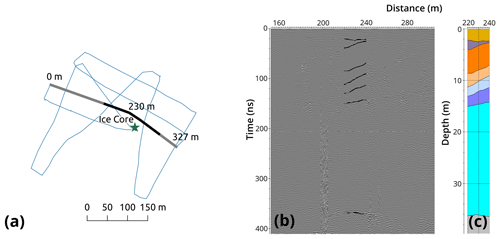
Figure 2Bouvet GPR. (a) Reference map depicts the full track of measurements (blue), the profile (grey), and the section shown in the radargram (black). (b) Radargram obtained in a south-easterly direction (downward) from 346 to 329 m a.s.l., shown with layer interpretation and (c) estimated depth of layers.
3.1 GPR
Given the scope of this paper, one example of a representative profile taken near the firn core is shown in the following section. Figures 2–5 show (a) a reference map of the track of measurements, (b) a section of the radargram, and (c) the estimated depth (up to 20 m) of the picked layers considering the variations in the propagation velocity given the density profile.
3.1.1 Bouvet Island
GPR data obtained at Bouvet Island generally show layers of accumulated snow. The reference map (Fig. 2a) shows the selected profile (grey line) descending from 357 to 339 m a.s.l. towards the south-east. Figure 2b shows the interpreted layers observed near the firn-core-extraction site. The estimated depth of the layers shows that there is about 2 m of continuous horizontal layering of snow. Below this layer, there is stratified firn that has been eroded by the effect of wind and the surface slope, reaching a layer of solid ice at 15 m from the surface. Another layer is detected at 36 m depth, which is interpreted as the bedrock. This depth is consistent with the estimated ice thickness observed from the ice cliffs to the south of the firn core-drilling site (Fig. S1). Ice thickness from the photograph is estimated relative to the expected size of the observed fur seals on the beach.
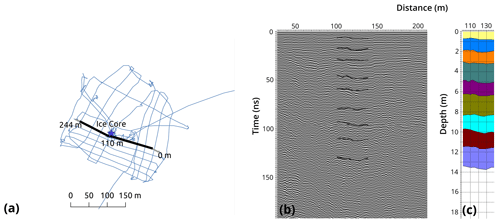
Figure 3Peter I GPR. (a) Reference map depicts the full track of measurements (blue), the profile (grey), and the section shown in the radargram (black). (b) Section of a radargram taken in an east-westerly direction with layer interpretation and (c) estimated depth of layers.
3.1.2 Peter I Island
Snow surface at the Peter I site was smooth (maximum 5∘ slope). Internal layers were only (and partially) traceable for the upper ∼ 25 m of the snow or firn pack. The maximum time window was set to reach an estimated depth of ∼ 43 m (Table 2), and bedrock was not detected. Figure 3a shows the track of measurements performed at the Peter I Island site, and the profile shown (Fig. 3b) is a section of the line (grey line), taken at increasing elevation from 718 m a.s.l. up to 726 m a.s.l. in a north-westerly direction. Figure 3c shows that the estimated depth for the stratified layers of snow in the upper 14 m was mostly continuous.
3.1.3 Mount Siple
The surface of the studied area at the Mount Siple site was relatively smooth (max 4∘ slope). Figure 4a shows the length and position of a full profile taken in a south-westerly direction, taken in an south-westerly direction rising from 678 to 685 m a.s.l., and ending at the firn-core-extraction position. Figure 4b shows the selected section where clear layering can be observed for the upper 20 m, with smooth depth variation through the profile length. Bedrock was not detected.
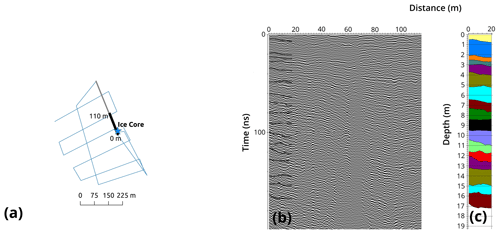
Figure 5Young Island GPR. (a) Reference map depicts the full track of measurements (blue), the profile (grey), and the section shown in the radargram (black). (b) Section of a radargram obtained walking in NW direction from the ice core, shown with layer interpretation and (c) estimated depth of layers. A crevasse was detected at 70 m from the starting point (discontinuity in the reflections).
3.1.4 Young Island
The Young Island site surface was flat with a compact snow. The maximum estimated depth of detected layers was ∼ 36 m (Table 2), and bedrock was not detected. Figure 5b shows a section of a selected profile taken in a north-westerly direction starting at the firn-core-extraction position; here multiple layers can be identified, but they are discontinuous, and the small distance between layers resulted in merging; thus they are not traceable through the full profile length.
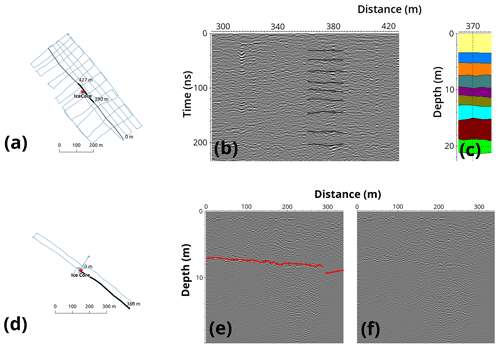
Figure 6Mertz GPR. Reference maps of (a) Mertz 1 and (d) Mertz fast-ice sites depicting the full track of measurements (blue), the profile (grey), and the section shown in the radargram (black). (b) Radargram representing a section of a transect crossing the ice core extraction point at Mertz 1 with layer interpretation and (c) estimated depth of layers. (e) Radargram collected at the fast-ice site, shown with one detected layer in red and (f) without layer interpretation.
3.1.5 Adélie Land coast (Mertz)
The Mertz 1 site (Cape Hurley) had a flat surface, consistent with observed internal layering. Layers could not be distinguished in the upper ∼7 m of snow and only reflected weakly beneath this depth; 11 distinct but discontinuous layers were identified down to a depth of 62 m (bedrock was not detected). We estimated this to be the approximate limit of signal propagation of the GPR system at this site. Figure 6a–c show a section of a profile taken in a north-westerly direction and the interpretation of layer depth in the upper 20 m near the firn core extraction.
Data quality for the Mertz fast-ice site was very poor (Fig. 6d–e). A single continuous layer at 6.8 m depth was the only one identified.
3.2 Melt records
Given their location, we expect all sites to experience some degree of surface melt. The elevation-corrected temperature for each SAI is compared with the 2 m temperature and uncorrected AWS temperature in Table 1. Surprisingly, the site least affected by melt is Bouvet, the warmest and most northerly location. Despite its northerly location, the average yearly temperature from ERA-5 (elevation-corrected) is −2.9 ∘C, with a maximum monthly temperature of −0.9 ∘C. The maximum value recorded by the AWS at 42 m a.s.l. was 6.7 ∘C (1997–2005, elevation-corrected). The average melt layer thickness in the Bouvet core is 0.3 cm, observed at a frequency of five layers per metre, with the largest measured melt layer just 3.95 cm (Table 2).
The coldest site is Mertz Glacier, with an annual average temperature (ERA-5 elevation-corrected) of −17.4 ∘C. The percentage of melt at this site is just 6 %, with a maximum layer thickness of 8.1 cm. The melt layer thickness at the Mertz fast-ice site appears to be lower; however, this only reflects visible melt layers in the top 2.2 m.
Average melt layer thickness at Peter I Island is comparable to that of Mount Siple, with melt percentage of 11 % and 10 %, respectively, reflecting the similar summer temperatures, −5.1 ∘C at Peter I and −5.2 ∘C at Mount Siple.
The site most affected by melt is Young Island, which has frequent melt layers averaging 6.57 cm and the largest single layer of 58 cm. The annual average temperature from this site is −9.2 ∘C, (ERA-5 1979–2017), with a maximum AWS temperature of 2.8 ∘C (February 1997). Melt layers occur throughout the profile but with the greatest density between 5–5.5 m and below 11 m depth. Most melt layers consist of bubbly ice, with a minority of thinner layers that are bubble-free or exhibit large crystals. We note that the visual method of determining melt layers is not sufficient to determine if the large layers result from individual melt events or are formed from a sequence of smaller events.
3.3 Relationship between GPR horizons and firn core melt layers
In order to explore the spatial extent of melt surrounding the firn core sites, we compare the firn core melt records with the GPR horizons. However, the melt observations from the firn core have a resolution of 1 mm, while the 400 MHz antenna provides a range of visibility of ∼ 35 cm for the dielectric-permittivity values at these firn conditions (Koppenjan, 2009; Arcone, 2009). Thus, we first reduce the resolution of the firn core-derived melt profiles by summing the total melt in a running 35 cm window. Only sections that would produce a strong enough (visible in the profiles at full resolution) reflection to be detected by the GPR are included in the comparison. The continuity of the GPR data has been assessed in profile sections of 20 m length near the firn core extraction (plot c in Figs. 2–6), and their mean depth has been used. Subsequently, we compared the potentially visible patterns from the firn core to the depth of the hand-picked layers in the radargrams (Fig. 7).
3.4 Density
The change in firn density with depth is dependent on the snow accumulation rate and temperature at the site. Higher temperature and lower accumulation rates result in the greatest change in density with depth. At our sites the depth–density profile exhibits more variability at the island sites (Bouvet, Peter I, Young) than the continental sites (Mertz and Mount Siple), reflecting the warmer island locations and the influence of surface melt (Fig. 8).
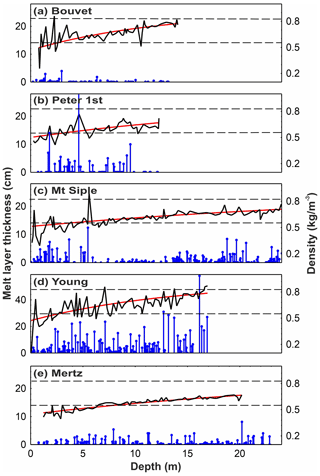
Figure 8Melt layer thickness (blue; cm), measured snow density (black), and fitted density curve (red) for each site: (a) Bouvet, (b) Peter I Island, (c) Mount Siple, (d) Young Island, and (e) Mertz 1. Note the axis change for plot d (Young Island). The horizontal lines represent the critical density (0.55 Kg m−3) and the pore close-off depth (0.83 Kg −3).
A fitted density curve is applied based on the assumption that firn densification is linearly related to the weight of overlying snow (Herron and Langway, 1980). The density with depth (ph) is calculated following Eq. (1):
where p is the density, pi is the density of ice (0.917 kg m−3), and h is the snow depth. The constants a and b are derived from the linear relationship between ln and depth, where ln(a) is the intercept, and b is the gradient. The first stage of densification relates to grain settling and packing and occurs below the “critical density” of about 0.55 kg m−3 (Herron and Langway, 1980). The second stage of densification (0.55–0.83 kg m−3) occurs when the firn air passages become closed off to form individual bubbles. The critical depth (zero intersection) and the close-off depth at each site are presented in Table 3.
3.5 Estimating the firn core bottom ages
The fitted density curve can provide a first approximation of the age scale (Table 3), based on the (water-equivalent) annual average P−E from ERA-5. We note that the resolution of ERA-5 may not be adequate to capture P−E at these sites and that snow accumulation may vary through time. It would have been preferable to use a densification model that accounts for the influence of melt (e.g. Lightenberg et al., 2011); however the current in situ observations at these sites do not allow for this. Thus, our approach is very simplified with the aim of establishing a preliminary bottom age for each site.
In the Herron and Langway densification model, the dominant densification processes in the upper part (ρ≤550 kg m−3) are grain settling and packing of snow grains (Herron and Langway, 1980). Undoubtedly, refreezing of meltwater and/or liquid precipitation also cause firn to densify. This is observed in Fig. 8 as jumps in the measured density corresponding to large melt events. However, if we assume that heat is released upon refreezing, the local firn temperature will also increase, further accelerating the densification. At the same time, ice layers lead to a higher average density, thereby reducing the potential densification rate. Although not ideal, the measured density value used in the equation will reflect the presence of melt. As such, the values of surface snow (or zero-intersection depth) are considerably higher than those modelled or observed for coastal Antarctica (van den Broeke, 2008).
We apply an error estimate to the bottom ages to account for the potential influence of melt, changing snow accumulation with time, and uncertainties in the ERA-5 P−E value. This is based on the difference between the age determined using the mean annual P−E value and the age determined when using an upper (annual P−E plus 1 standard deviation) or lower (annual P−E minus 1 standard deviation) P−E value. The error variability reflects the variability in precipitation at each site and increases with depth and age.
For the sites where bedrock was not detected, we estimate the bottom age of an ice core drilled to 100 m depth (Table 3). This suggests that the oldest ice would be reached at Mertz 1 (1849 ± 64 years) and the youngest ice at Mount Siple (1912 ± 35 years).
Based on the results we aim to establish which of the sites would be suitable for future deep-drilling expeditions based on (1) the firn conditions and internal layering in the upper ice column, (2) the extent of surface melt and the potential impact on proxy preservation, and (3) potential bottom ages.
4.1 Firn conditions and internal layering in the upper ice column
4.1.1 Density
A linear relationship exists between the 2 m temperature from ERA-5 and the critical depth (r2=0.57, p>0.05), which is reached first at Bouvet, the most northerly location and the warmest site (Tables 1 and 3). Young Island is the only site where the close-off depth is reached, which exceeds this density threshold (0.83 kg m−3) at 16.6 m. This suggests that pore close-off has been achieved, when air can no longer be excluded, and further densification takes place by compression of the bubbles. However, the presence of a large melt layer at this depth suggests this may be the cause of the density increase. Based on the fitted density profile, the actual close-off depth occurs at 21 m. The second-fastest close-off depth occurs at Bouvet (28.65 m), considerably shallower than the two coastal Antarctic sites (Mount Siple and Mertz 1).
Table 3Ice-core-derived zero-depth intersection and close-off depth. Estimated age (years CE) at the bottom of the core and at 100 m, based on the measured ice core density.
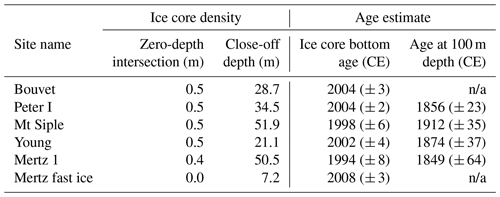
n/a: not applicable.
Surface densities, critical depths, and close-off depths at the continental sites (Mount Siple and Mertz 1) are consistent with modelled values (van den Broeke, 2008). A compilation of observed (and modelled) Antarctic snow densities suggest a range of 6–26 m (modelled 4–29.5 m) for the critical depth and 34–115 m (modelled 45–115 m) for pore close-off. The values for Bouvet, Peter I, and Young Island are close to the modelled values for coastal Antarctica; however, the pore close-off depth at both Bouvet and Young Island is achieved faster than the lowest reported depth for an Antarctic site (34 m at Upstream B, West Antarctica) (van den Broeke, 2008). The presence of melt layers, with a greater density than the surrounding firn, may bias our close-off estimates to shallower depths. In addition to the influence of temperature, the rapid densification on the SAIs may be caused by layer stretching and compression related to ice flow that is not well understood at these locations.
4.1.2 GPR
The aim of the GPR data was to give a preliminary characterization of each site, particularly the distribution, continuity, and clearness of the horizons observed in this data. Bouvet was the only site where bedrock was detected, suggesting that the maximum depth of an ice core from this site is ∼ 40 m. Evidence of wind scouring in the reflections may impact the proxy preservation at this site. The profiles at Peter I, Mount Siple, and Mertz indicate more uniform internal structure, with traceable layers in the top 20 m. The largest number of layers was identified at Young Island, but many were discontinuous or difficult to trace. The deepest layer detected was at Mertz, the coldest site, where layers were traceable to a depth of 62 m.
4.1.3 Case study: Mertz fast ice
This Mertz fast-ice site is fundamentally different in character from the others presented in this study. While we believe the surface snow to be meteoric, it does not sit atop grounded ice but rather a large wedge of multiyear sea ice, held fast between the AAE and Mertz Glacier tongues (Fig. 1d). The topmost layers of snow and firn appeared to be typical of surface snow. However, at a drill depth of 6.23 m the core was saturated with liquid seawater (a strong attenuator of the radar signal). Ice recovered below this depth was different in character from the surface, being solid ice containing bubbles and interstitially saturated with salt water. There was a standing water table in the borehole at this same depth. These observations, together with the clear radar reflector at just over 6.8 m (Fig. 6), the absence of reflectors below this, and the site's elevation of ∼ 6 m a.s.l., lead to the conclusion that the fast ice is saturated with seawater below sea level.
If the fast ice is floating (i.e. supported buoyantly), our measurement of the dry freeboard thickness allows us to estimate the total thickness of the fast-ice wedge. The average density of the top 6 m is 0.55 ± 0.05 kg m−3, increasing to 0.85 ± 0.05 kg m−3 below this. Assuming a seawater density of 1.0275 ± 0.004 kg m−3, freeboard thickness of 6.2 m, and a mean density of the ice below the water table of 0.85 ± 0.05 kg m−3, the total ice-equivalent thickness of the ice at this site is ∼ 30 m. However, there are large uncertainties in this calculation. The radargram indicates that the fast ice increases in thickness away from the drill site by several metres. While this site is not likely to provide typical geochemical-proxy records, it may be of interest to future studies of multiyear sea ice.
4.2 Extent of surface melt and the potential impact on proxy preservation
4.2.1 Melt recorded in the firn core
Surface melting occurs in response to a positive energy balance at the snow surface and is strongly correlated with surface air temperature. The Antarctic ice sheet experiences little melt due to consistently low temperature; however the coastal margins and areas of the Antarctic Peninsula are subject to surface melting (van Wessem et al., 2016). The relationship between surface melt and surface temperature has been exploited to reconstruct past climate in Antarctic ice cores (Abram et al., 2013). However, the presence of too much surface melt can damage the climate proxies they contain.
The influence of meltwater on ice-core-proxy preservation has been explored for Arctic ice cores (Koerner, 1997). Here, meltwater percolation can allow insoluble microparticles to migrate to the melting surface, causing a spike in concentrations, and influence the stable-water-isotope record, a commonly used proxy for past surface temperature. Seasonal melting can cause run-off of near-surface snow and melt and refreezing at the base of the annual snowpack. This can redistribute the stable-water-isotope profile, resulting in a warm- or cold-biased record. The influence on both stable water isotopes and chemistry can have a major impact on the ability to date ice cores using annual layer counting. The site most affected by melt is Young Island, with 47 % of the firn core characterized as melt. Given the island's location south of the polar front and the seasonal sea ice zone (Fig. 1), the evidence of extensive surface melting is unexpected, especially when considering that the average temperature at Young Island is 6.4∘ colder than Bouvet, the site least affected by melt. It is likely that the resolution of ERA-5 is not sufficient to capture local surface temperature; however, the 3-hourly data from the AWS (1993–1997) reveal considerable variability.
The maximum temperature recorded by the Young AWS (elevation-corrected) is 2.8 ∘C (February 1997), with temperatures in 20 of the 67 months of AWS data exceeding 0 ∘C. The annual average temperature at Young Island is comparable with Peter I, with a lower maximum AWS temperature. However, the largest melt layer at Young is almost twice that of Peter I and the percentage melt over 4 times higher. Solar radiation is the dominant driver of surface melting, although atmospheric thermodynamics and cloud radiative properties also play a role. Thus, our study demonstrates that, for the SAIs, surface temperature alone is not a reliable indicator of potential melt damage.
The average melt layer thickness at all sites (except Young Island) is considerably lower than the mean melt layer width of 3.2 cm observed at the James Ross Island ice core, from the northern Antarctic Peninsula (Abram et al., 2013). The percentage of melt per year is dependent on the measured snow accumulation. The estimated snow accumulation at Bouvet is 0.59 m water equivalent, based on annual layer counting of chemical and isotopic species (King et al., 2019b). The annual layer counting of the other subICE cores has not yet been completed; however based on our estimates (Sect. 3.4), it is a reasonable assumption that the snow accumulation at these maritime islands will be equal to or more than the snow accumulation at James Ross Island (0.62 ± 0.14 m water equivalent). Thus, the potential for proxy preservation and climate reconstructions is promising at these sites.
Given the degree of melt at Young Island, it seems likely that the proxy preservation may be compromised. However, an evaluation of the firn or ice microstructure may help determine the extent to which meltwater has percolated through the layers.
4.2.2 Comparison of firn core melt with GPR layers
There appears to be little correlation between the melt observed in the core and the layers traced in the GPR. The relationship is particularly poor for Young Island, where the core shows a high number of thin melt layers, seen in the radar data as very dense non-continuous layering. Although it is not possible to determine the spatial extent of melting based on the GPR profiles, the findings suggest that density variations alone cannot explain the internal layering.
The presented comparison method is subject to several sources of uncertainty: (1) the manual picking of the GPR layer; (2) the distance between the firn-core-extraction point and the section of the radar data; and (3) the use of average depth in sections of 20 m distance, especially for the sites that exhibit an incline (e.g. Bouvet and Mount Siple).
4.3 Potential bottom ages of deeper ice cores
One of the aims of this study was to establish the SAI's suitability for future deep-ice-core-drilling projects. A useful indicator is the potential bottom age at each site. The estimated firn core bottom ages range from 2004 CE (± 3 years), at both the Peter I and Bouvet firn cores, to 1994 CE (± 8 years) at Mertz 1 (Table 3).
To date, only the Bouvet firn core has been independently dated. Annual layer counting, using a suite of chemical and isotopic species, yielded a bottom age of 2001 CE (King et al., 2019). Although older than the bottom age estimate using the density profile, it is within error (2004 CE ± 3 years), adding confidence to this approach but suggesting our ages may be too conservative. The offset may be explained by an over-estimate in the P−E derived from ERA-5 or suggest the influence of post-depositional processes such as wind scouring or ablation.
It is difficult to estimate a potential age limit for a core drilled to bedrock at the Young, Peter I, and Mertz 1 sites since the ice thickness was beyond the penetration depth of the GPR. For example, at Mertz 1 a bottom age of 1926 CE (± 34 years) is estimated based on a GPR bottom depth of 63 m (Table 2), although the ice could feasibly be much deeper than this. At the Bouvet site, where we interpret the layer at ∼ 40 m as bedrock, the maximum potential age is 1971 CE (± 11 years). However, considerably deeper (and therefore older) ice may be present at higher elevations. These results suggest that the subICE firn core records will be suitable for obtaining sub-annual-resolution climate records with the potential to capture climate variability over multi-decadal timescales.
The estimated firn core bottom age at Bouvet Island, together with the observed visible ash layers (Fig. S1), offers a glimpse at the volcanic history of this remote island. The last known eruption was 50 BCE; however, visible layers in the upper ∼ 20 m suggest the island has been volcanically active as recently as ∼ 1998. The regularity of the layers in the ice cliffs, visible all around the island, indicate frequent volcanic activity has occurred during the 20th century. This is consistent with the persistent volcanic activity observed on the nearby South Sandwich Islands, with visible ash clouds identified in the satellite records and even visible from the ship during the ACE (March 2017). We note that the visible ash layers at Bouvet (Fig. S1) may have been deposited from the South Sandwich Islands, but further analysis will help establish the source.
Initial results from five shallow firn cores drilled in the sub-Antarctic islands and coastal Antarctica suggest that these locations may be suitable for short-term climate reconstructions and up to centennial-scale reconstructions at some sites if deeper cores could be retrieved. Evidence that these firn cores span the 20th century, a period of significant global climate change, is exciting. The GPR surveys suggest relatively uniform layering at most sites, at least to the depth of the firn cores, suitable for firn-core-proxy reconstructions. However, evidence of crevassing at some locations (Young and Peter I) demonstrates the importance of a thorough geophysical survey before contemplating deeper drilling at these sites. At Bouvet Island, regular volcanic ash deposits during the 20th century suggest the island is still volcanically active.
The impact of melt is less severe than expected at some locations, especially Bouvet Island, but more severe at others. Young Island, part of the Balleny island chain off the coast of Adèlie Land, is the most susceptible to melt. However, the observed melt layer thickness at the other sites is less than that observed from the James Ross Island ice core, which yielded palaeoclimate reconstructions (Abram et al., 2013). Proxy preservation was not a concern in this ice core, suggesting that melt will also not adversely influence the climate record contained in the sub-Antarctic firn cores. The observed increase in melt intensity at James Ross Island since the mid-20th century was linked to warming surface temperature. Thus, the comparable melt intensity observed at some of the SAIs may be evidence that the 20th-century warming at these locations was analogous to that on the Antarctic Peninsula.
Based on the measured density profile and the P−E from ERA-5, the estimated bottom ages of the subICE cores range from 2004 (Peter I and Bouvet) to 1994 (Mertz 1), suggesting that these records should contain a multi-decadal record of climate variability in this data-sparse region. We were unable to obtain ice thickness estimates for all sites, with the exception of Bouvet; however visible layers were identified in the GPR records to depths of 60 m. Even with a conservative estimate, it is possible that deeper ice cores drilled on these SAIs would have the potential to capture climate variability during the 20th century but most likely considerably longer.
All data will be stored at the UK Polar Data Centre and made available by directly contacting Liz Thomas (lith@bas.ac.uk).
The supplement related to this article is available online at: https://doi.org/10.5194/tc-15-1173-2021-supplement.
ERT led the project; ERT, GG, JBP, ACFK, BM, and MP collected the data in the field; ERT, JBP, ACFK, and DEM processed the ice core data; GG and MP processed the GPR data; all authors contributed to writing and editing the paper.
The authors declare that they have no conflict of interest.
Funding was provided to subICE by École Polytechnique Fédérale de Lausanne, the Swiss Polar Institute, and Ferring Pharmaceuticals Inc. Elizabeth Ruth Thomas received core funding from the Natural Environment Research Council to the British Antarctic Survey's Ice Dynamics and Palaeoclimate programme. Amy Constance Faith King was jointly supported by Selwyn College, Cambridge, and the NERC doctoral training programme (grant no. NE/L002507/1). Joel B. Pedro acknowledges support from the European Research Council under the European Community's Seventh Framework Programme (FP7/2007e2013) and ERC grant agreement 610055 as part of the ice2ice project. We are grateful to the Norwegian Polar Institute for granting us permission to visit Bouvet (permit reference: 2016/115-25). The authors appreciate the support of the University of Wisconsin-Madison Automatic Weather Station programme for the data set, data display, and information as well as the NSF (grant no. ANT-1543305) and ECMWF for providing ERA-5 reanalysis data. We thank Laura Gerish (BAS) for producing the maps. Data used in this study are available through the UK Polar Data Centre. The authors would like to acknowledge the coordinators and participants of the Antarctic Circumnavigation Expedition for facilitating collection of the subICE cores, especially David Walton, Christian de Marliave, Julia Schmale, Robert Brett, Sergio Rodrigues, Francois Bernard, Roger Stilwell, and Frederick Paulsen. We thank Howard Conway, an anonymous reviewer, and editor Adam Booth for their valuable suggestions.
This research has been supported by the École Polytechnique Fédérale de Lausanne, the Swiss Polar Institute, and Ferring Pharmaceuticals Inc. (grant no. subICE).
This paper was edited by Adam Booth and reviewed by Howard Conway and one anonymous referee.
Abram, N. J., Mulvaney, R., Wolff, E. W., Triest, J., Kipfstuhl, S., Trusel, L. D., Vimeux, F., Fleet, L., and Arrowsmith, C.: Acceleration of snow melt in an Antarctic Peninsula ice core during the twentieth century, Nat. Geosci., 6, 404–411, 2013.
Arcone, S.: Glaciers and Ice Sheets, in: Ground Penetrating Radar Theory and Applications, edited by: Jol, H., Oxford, Elsevier, 361–392, 2009.
Campagne, P., Crosta, X., Houssais, M. N., Swingedouw, D., Schmidt, S., Martin, A., Devred, E., Capo, S., Marieu, V., Closset, I., and Massé, G.: Glacial ice and atmospheric forcing on the Mertz Glacier Polynya over the past 250 years, Nat. Commun., 6, 6642, https://doi.org/10.1038/ncomms7642, 2015.
Cook, A. J., Poncet, S., Cooper, A. P. R., Herbert, D. J., and Christie, D.: Glacier retreat on South Georgia and implications for the spread of rats, Antarc. Sci., 22, 255–263, 2010.
Copernicus Climate Change Service (C3S): ERA5: Fifth generation of ECMWF atmospheric reanalyses of the global climate, Copernicus Climate Change Service Climate Data Store (CDS), February 2020, available at: https://cds.climate.copernicus.eu/cdsapp{#}!/home (last access: April 2020), 2017.
Emile-Geay, J., McKay, N. P., Kaufman, D. S., von Gunten, L., Wang, J., Anchukaitis, K. J., Abram, N. J., Addison, J. A., Curran, M. A. J., Evans, M. N., Henley, B. J., Hao, Z., Martrat, B., McGregor, H. V., Neukom, R., Pederson, G. T., Stenni, B., Thirumalai, K., Werner, J. P., Xu, C., Divine, D. V., Dixon, B. C., Gergis, J., Mundo, I. A., Nakatsuka, T., Phipps, S. J., Routson, C. C., Steig, E. J., Tierney, J. E., Tyler, J. J., Allen, K. J., Bertler, N. A. N., Björklund, J., Chase, B. M., Chen, M.-T., Cook, E., de Jong, R., DeLong, K. L., Dixon, D. A., Ekaykin, A. A., Ersek, V., Filipsson, H. L., Francus, P., Freund, M. B., Frezzotti, M., Gaire, N. P., Gajewski, K., Ge, Q., Goosse, H., Gornostaeva, A., Grosjean, M., Horiuchi, K., Hormes, A., Husum, K., Isaksson, E., Kandasamy, S., Kawamura, K., Kilbourne, K. H., Koç, N., Leduc, G., Linderholm, H. W., Lorrey, A. M., Mikhalenko, V., Mortyn, P. G., Motoyama, H., Moy, A. D., Mulvaney, R., Munz, P. M., Nash, D. J., Oerter, H., Opel, T., Orsi, A. J., Ovchinnikov, D. V., Porter, T. J., Roop, H. A., Saenger, C., Sano, M., Sauchyn, D., Saunders, K. M., Seidenkrantz, M.-S., Severi, M., Shao, X., Sicre, M.-A., Sigl, M., Sinclair, K., St. George, S., St. Jacques, J.-M., Thamban, M., Kuwar Thapa, U., Thomas, E. R., Turney, C., Uemura, R., Viau, A. E., Vladimirova, D. O., Wahl, E. R., White, J. W. C., Yu, Z., Zinke, J., and Consortium, P. A. K.: A global multiproxy database for temperature reconstructions of the Common Era, Sci. Data, 4, 170088, https://doi.org/10.1038/sdata.2017.88, 2017.
Favier, L., Durand, G., Cornford, S. L., Gudmundsson, G. H., Gagliardini, O., Gillet-Chaulet, F., Zwinger, T., Payne, A. J., and Le Brocq, A. M.: Retreat of Pine Island Glacier controlled by marine ice-sheet instability, Nat. Clim. Change, 4, 117–121, 2014.
Hatherton, T., Dawson, E. W., and Kinsky, F. C.: Balleny Island's Reconnaissance Expedition, 1964, New Zealand Journal of Geology and Geophysics, 8, 164–179, 1965.
Herron, M. M. and Langway, C. C.: Firn Densification: An Empirical Model, J. Glaciol., 25, 373–385, 1980.
Joughin, I., Smith, B. E., and Medley, B.: Marine Ice Sheet Collapse Potentially Under Way for the Thwaites Glacier Basin, West Antarctica, Science, 344, 735, https://doi.org/10.1126/science.1249055, 2014.
King, A. C. F., Thomas, E. R., Pedro, J. B., Markle, B., Potocki, M., Jackson, S. L., Wolff, E., and Kalberer, M.: Organic Compounds in a Sub-Antarctic Ice Core: A Potential Suite of Sea Ice Markers, Geophys. Res. Lett., 46, 9930–9939, 2019.
Koerner, R. M.: Some comments on climatic reconstructions from ice cores drilled in areas of high melt, J. Glaciol., 43, 90–97, 2017.
Koppenjan, S.: Ground Penetrating Radar Systems and Design, in: Ground Penetrating Radar Theory and Applications, edited by: Jol, H., Oxford, Elsevier, 73–97, 2009.
Lacarra, M., Houssais, M.-N., Herbaut, C., Sultan, E., and Beauverger, M.: Dense shelf water production in the Adélie Depression, East Antarctica, 2004–2012: Impact of the Mertz Glacier calving, J. Geophys. Res.-Oceans, 119, 5203–5220, 2014.
Ligtenberg, S. R. M., Helsen, M. M., and van den Broeke, M. R.: An improved semi-empirical model for the densification of Antarctic firn, The Cryosphere, 5, 809–819, https://doi.org/10.5194/tc-5-809-2011, 2011.
Looyenga, H.: Dielectric constants of heterogeneous mixtures, Physica, 31, 401–406, 1965.
Martin, P. and Peel, D.: The Spatial Distribution of 10 m Temperatures in the Antarctic Peninsula, J. Glaciol., 20, 311–317, https://doi.org/10.3189/S0022143000013861, 1978.
Mayewski, P. A., Kuli, A., Casassa, G., Arėvalo, M., Dixon, D. A., Grigholm, B., Handley, M. J., Hoffmann, H., Introne, D. S., Kuli, A. G., Potocki, M., and Sneed, S. B.: Initial reconnaissance for a South Georgia ice core, J. Glaciol., 62, 54–61, 2016.
McGlone, M. S.: The Late Quaternary peat, vegetation and climate history of the Southern Oceanic Islands of New Zealand, Quat. Sci. Rev., 21, 683–707, 2002.
Medley, B. and Thomas, E. R.: Increased snowfall over the Antarctic Ice Sheet mitigated twentieth-century sea-level rise, Nat. Clim. Change, 9, 34–39, 2019.
Perren, B. B., Hodgson, D. A., Roberts, S. J., Sime, L., Van Nieuwenhuyze, W., Verleyen, E., and Vyverman, W.: Southward migration of the Southern Hemisphere westerly winds corresponds with warming climate over centennial timescales, Commun. Earth Environ., 1, 58, https://doi.org/10.1038/s43247-020-00059-6, 2020.
Saunders, K. M., Hodgson, D. A., and McMinn, A.: Quantitative relationships between benthic diatom assemblages and water chemistry in Macquarie Island lakes and their potential for reconstructing past environmental changes, Antarc. Sci., 21, 35–49, 2008.
Saunders, K. M., Roberts, S. J., Perren, B., Butz, C., Sime, L., Davies, S., Van Nieuwenhuyze, W., Grosjean, M., and Hodgson, D. A.: Holocene dynamics of the Southern Hemisphere westerly winds and possible links to CO2 outgassing, Nat. Geosci., 11, 650–655, 2018.
Spikes, V. B., Hamilton, G. S., Arcone, S. A., Kaspari, S., and Mayewski, P. A.: Variability in accumulation rates from GPR profiling on the West Antarctic plateau, Ann. Glaciol., 39, 238–244, 2004.
Tetzner, D., Thomas, E., and Allen, C.: A Validation of ERA5 Reanalysis Data in the Southern Antarctic Peninsula – Ellsworth Land Region, and Its Implications for Ice Core Studies, Geosciences, 9, 289, https://doi.org/10.3390/geosciences9070289, 2019.
Thomas, E. R., Allen, C. S., Etourneau, J., King, A. C. F., Severi, M., Winton, V. H. L., Mueller, J., Crosta, X., and Peck, V. L.: Antarctic Sea Ice Proxies from Marine and Ice Core Archives Suitable for Reconstructing Sea Ice over the Past 2000 Years, Geosci., 9, 506, https://doi.org/10.3390/geosciences9120506, 2019.
van den Broeke, M.: Depth and Density of the Antarctic Firn Layer, Arc. Antarc. Alp. Res., 40, 432–438, 2008.
Van der Putten, N., Mauquoy, D., Verbruggen, C., and Björck, S.: Subantarctic peatlands and their potential as palaeoenvironmental and palaeoclimatic archives, Quat. Int., 268, 65–76, 2012.
Walton, D. and Thomas, J.: Cruise Report – Antarctic Circumnavigation Expedition (ACE) 20th December 2016 – 19th March 2017 (Version 1.0), Zenodo, https://doi.org/10.5281/zenodo.1443511, 2018.
Whitehead, H., McGill, B., and Worm, B.: Diversity of deep-water cetaceans in relation to temperature: implications for ocean warming, Ecol. Lett., 11, 1198–1207, 2008.







